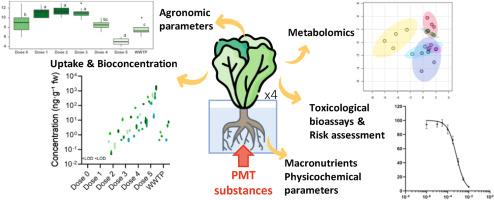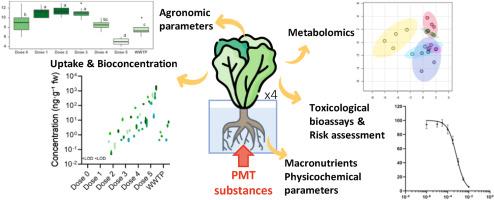水培再生水灌溉:PMT物质的剂量依赖性吸收及其对生菜和人体健康的影响
IF 7.3
2区 环境科学与生态学
Q1 ENVIRONMENTAL SCIENCES
引用次数: 0
摘要
水培农业结合再生水的利用是解决全球水资源短缺的可持续战略。然而,再生水中持久性、流动性和毒性(PMT)物质的存在引起了人们对环境安全和食品安全的新关注。本研究考察了在可控温室条件下,文拉法辛、o -去甲基文拉法辛、氧氟沙星、特布林、h -苯并三唑、(4+5)-甲基苯并三唑、佳乐咪酮、全氟丁磺酸(PFBS)和全氟戊酸(PFPeA)等9种化合物PMT混合物5个浓度水平(0.05-500 μg·L-1)对水培生菜的影响。进行了多学科评估,包括污染物吸收和生物积累、农艺性能、植物代谢组学、体外毒理学生物测定和理论上的人类健康风险评估。结果表明,PFPeA和galaxolidone分别达到559和483 ng·g-1鲜重。农艺影响范围从环境相关低浓度下的致光反应到高浓度下的光毒性胁迫。虽然在毒理学生物测定中没有检测到影响,但PFPeA浓度≥50 μg·L-1时超过了风险阈值(HQ = 1-25),表明人类可能通过食用蔬菜作物接触到PFPeA。这些发现强调需要进行符合环境实际的剂量反应研究,以便为监管阈值提供信息,并确保在粮食生产系统中安全使用再生水。本文章由计算机程序翻译,如有差异,请以英文原文为准。


Reclaimed water irrigation in hydroponics: Dose–dependent uptake of PMT substances and implications for lettuce and human health
Hydroponic agriculture combined with reclaimed water use represents a sustainable strategy to address global water scarcity. However, the presence of persistent, mobile, and toxic (PMT) substances in reclaimed water raises emerging concerns for environmental safety and food security. This study examines the impact of five concentration levels (0.05–500 μg L−1) of a nine-compound PMT mixture, including venlafaxine, O-desmethyl venlafaxine, ofloxacin, terbutryn, 1H-benzotriazole, (4 + 5)-methylbenzotriazole, galaxolidone, perfluorobutanesulfonic acid (PFBS), and perfluoropentanoic acid (PFPeA), on hydroponically cultivated lettuce under controlled greenhouse conditions. A multidisciplinary assessment was conducted, including contaminant uptake and bioaccumulation, agronomic performance, plant metabolomics, in-vitro toxicological bioassays, and a theoretical human health risk assessment. Results showed compound-specific accumulation, with PFPeA and galaxolidone reaching 559 and 483 ng g−1 fresh weight, respectively. Agronomic effects ranged from hormetic responses at environmentally relevant low concentrations to phototoxic stress at higher exposures. Although no effects were detected in toxicological bioassays, PFPeA exceeded risk thresholds (HQ = 1–25) at concentrations ≥50 μg L−1, indicating potential concern for human exposure via vegetable crop consumption. These findings underscore the need for environmentally realistic dose–response studies to inform regulatory thresholds and ensure the safe use of reclaimed water in food production systems.
求助全文
通过发布文献求助,成功后即可免费获取论文全文。
去求助
来源期刊

Environmental Pollution
环境科学-环境科学
CiteScore
16.00
自引率
6.70%
发文量
2082
审稿时长
2.9 months
期刊介绍:
Environmental Pollution is an international peer-reviewed journal that publishes high-quality research papers and review articles covering all aspects of environmental pollution and its impacts on ecosystems and human health.
Subject areas include, but are not limited to:
• Sources and occurrences of pollutants that are clearly defined and measured in environmental compartments, food and food-related items, and human bodies;
• Interlinks between contaminant exposure and biological, ecological, and human health effects, including those of climate change;
• Contaminants of emerging concerns (including but not limited to antibiotic resistant microorganisms or genes, microplastics/nanoplastics, electronic wastes, light, and noise) and/or their biological, ecological, or human health effects;
• Laboratory and field studies on the remediation/mitigation of environmental pollution via new techniques and with clear links to biological, ecological, or human health effects;
• Modeling of pollution processes, patterns, or trends that is of clear environmental and/or human health interest;
• New techniques that measure and examine environmental occurrences, transport, behavior, and effects of pollutants within the environment or the laboratory, provided that they can be clearly used to address problems within regional or global environmental compartments.
 求助内容:
求助内容: 应助结果提醒方式:
应助结果提醒方式:


